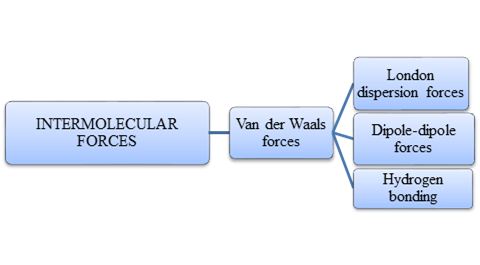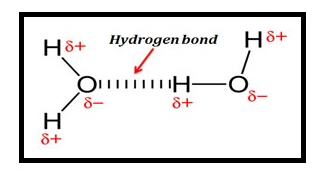
Bundle: General Chemistry, Loose-leaf Version, 11th + OWLv2, 4 terms (24 months) Printed Access Card
11th Edition
ISBN: 9781337128391
Author: Darrell Ebbing, Steven D. Gammon
Publisher: Cengage Learning
expand_more
expand_more
format_list_bulleted
Question
Chapter 11, Problem 11.131QP
Interpretation Introduction
Interpretation:
The unusual properties of Water and how hydrogen bonding does explain these unusual properties has to be explained.
Concept introduction:
Intermolecular forces are termed as the forces acting “between molecules” that is components of a substance. Intramolecular forces are the forces that operate “within a molecule”. The prefix “inter” mean “among” and “intra” mean “within”.

Arrangement of major types of intermolecular forces in increasing order of strength:
- Hydrogen bonding: Hydrogen bonding is weak attractive force that occurs between hydrogen atom bounded to high electronegative atom such as Nitrogen, Oxygen or Fluorine and another adjacent atom having a lone pair of electrons.
- Hydrogen bonding in water molecule: Hydrogen bond involves a hydrogen atom of one water molecule bounded to a lone pair of electrons on Oxygen atom of another molecule of water.

Figure.1
Expert Solution & Answer
Trending nowThis is a popular solution!

Chapter 11 Solutions
Bundle: General Chemistry, Loose-leaf Version, 11th + OWLv2, 4 terms (24 months) Printed Access Card
Ch. 11.2 - The heat of vaporization of ammonia is 23.4...Ch. 11.2 - Shown here is a representation of a closed...Ch. 11.2 - Prob. 11.2ECh. 11.2 - Selenium tetrafluoride, SeF4, is a colorless...Ch. 11.3 - Prob. 11.4ECh. 11.3 - When camping at high altitude, you need to pay...Ch. 11.5 - Consider two liquids, labeled A and B, that are...Ch. 11.5 - List the different intermolecular forces you would...Ch. 11.5 - Arrange the following hydrocarbons in order of...Ch. 11.5 - At the same temperature, methyl chloride, CH3Cl,...
Ch. 11.5 - A common misconception is that the following...Ch. 11.6 - Prob. 11.8ECh. 11.6 - Prob. 11.9ECh. 11.7 - Figure 11.35 shows solid dots (atoms) forming a...Ch. 11.8 - Shown here is a representation of a unit cell for...Ch. 11.9 - Lithium metal has a body-centered cubic structure...Ch. 11.9 - Potassium metal has a body-centered cubic...Ch. 11 - List the different phase transitions that are...Ch. 11 - Describe how you could purify iodine by...Ch. 11 - Prob. 11.3QPCh. 11 - Explain why 15 g of steam at 100C melts more ice...Ch. 11 - Why is the heat of fusion of a substance smaller...Ch. 11 - Explain why evaporation leads to cooling of the...Ch. 11 - Describe the behavior of a liquid and its vapor in...Ch. 11 - Gases that cannot be liquefied at room temperature...Ch. 11 - Prob. 11.9QPCh. 11 - Why does the vapor pressure of a liquid depend on...Ch. 11 - Prob. 11.11QPCh. 11 - Prob. 11.12QPCh. 11 - Prob. 11.13QPCh. 11 - Prob. 11.14QPCh. 11 - Prob. 11.15QPCh. 11 - Prob. 11.16QPCh. 11 - Prob. 11.17QPCh. 11 - What is the coordination number of Cs in CsCl? of...Ch. 11 - Explain in words how Avogadros number could be...Ch. 11 - Prob. 11.20QPCh. 11 - Prob. 11.21QPCh. 11 - Prob. 11.22QPCh. 11 - Under the right conditions, hydrogen gas, H2, can...Ch. 11 - An element crystallizes with a simple cubic...Ch. 11 - Intermolecular Forces The following picture...Ch. 11 - Heat and Molecular Behavior Part 1: a Is it...Ch. 11 - Shown here is a curve of the distribution of...Ch. 11 - Consider a substance X with a Hvap = 20.3 kJ/mol...Ch. 11 - Prob. 11.29QPCh. 11 - Prob. 11.30QPCh. 11 - Prob. 11.31QPCh. 11 - Prob. 11.32QPCh. 11 - Prob. 11.33QPCh. 11 - Prob. 11.34QPCh. 11 - Prob. 11.35QPCh. 11 - Prob. 11.36QPCh. 11 - Prob. 11.37QPCh. 11 - Prob. 11.38QPCh. 11 - Use Figure 11.7 to estimate the boiling point of...Ch. 11 - Use Figure 11.7 to estimate the boiling point of...Ch. 11 - An electric heater coil provided heat to a 15.5-g...Ch. 11 - Prob. 11.42QPCh. 11 - Isopropyl alcohol, CH3CHOHCH3, is used in rubbing...Ch. 11 - Liquid butane, C4H10, is stored in cylinders to be...Ch. 11 - Water at 0C was placed in a dish inside a vessel...Ch. 11 - A quantity of ice at 0.0C was added to 33.6 g of...Ch. 11 - A quantity of ice at 0C is added to 64.3 g of...Ch. 11 - Steam at 100C was passed into a flask containing...Ch. 11 - Chloroform, CHCl3, a volatile liquid, was once...Ch. 11 - Prob. 11.50QPCh. 11 - White phosphorus, P4, is normally a white, waxy...Ch. 11 - Carbon disulfide, CS2 is a volatile, flammable...Ch. 11 - Prob. 11.53QPCh. 11 - Prob. 11.54QPCh. 11 - Prob. 11.55QPCh. 11 - Prob. 11.56QPCh. 11 - Which of the following substances can be liquefied...Ch. 11 - A tank of gas at 21C has a pressure of 1.0 atm....Ch. 11 - Prob. 11.59QPCh. 11 - Krypton, Kr, has a triple point at 169C and 133...Ch. 11 - Prob. 11.61QPCh. 11 - The heats of vaporization of liquid O2, liquid Ne,...Ch. 11 - For each of the following substances, list the...Ch. 11 - Which of the following compounds would you expect...Ch. 11 - Arrange the following substances in order of...Ch. 11 - Arrange the following substances in order of...Ch. 11 - Methane, CH4, reacts with chlorine, Cl2, to...Ch. 11 - The halogens form a series of compounds with each...Ch. 11 - Prob. 11.69QPCh. 11 - Prob. 11.70QPCh. 11 - List the following substances in order of...Ch. 11 - Arrange the following compounds in order of...Ch. 11 - Classify each of the following by the type of...Ch. 11 - Classify each of the following by the type of...Ch. 11 - Classify each of the following solid elements as...Ch. 11 - Which of the following do you expect to be...Ch. 11 - Prob. 11.77QPCh. 11 - Arrange the following substances in order of...Ch. 11 - Prob. 11.79QPCh. 11 - On the basis of the description given, classify...Ch. 11 - Prob. 11.81QPCh. 11 - Associate each of the solids BN, P4S3, Pb, and...Ch. 11 - Prob. 11.83QPCh. 11 - How many atoms are there in a body-centered cubic...Ch. 11 - Metallic iron has a body-centered cubic lattice...Ch. 11 - Nickel has a face-centered unit cell with all...Ch. 11 - Copper metal has a face-centered cubic structure...Ch. 11 - Barium metal has a body-centered cubic lattice...Ch. 11 - Gold has cubic crystals whose unit cell has an...Ch. 11 - Chromium forms cubic crystals whose unit cell has...Ch. 11 - Assume X has a body-centered cubic lattice with...Ch. 11 - Lead has a face-centered cubic lattice with all...Ch. 11 - Prob. 11.93QPCh. 11 - Metallic barium has a body-centered cubic...Ch. 11 - Prob. 11.95QPCh. 11 - Prob. 11.96QPCh. 11 - Prob. 11.97QPCh. 11 - Prob. 11.98QPCh. 11 - Prob. 11.99QPCh. 11 - Prob. 11.100QPCh. 11 - Prob. 11.101QPCh. 11 - Prob. 11.102QPCh. 11 - Describe the formation of hydrogen bonds in...Ch. 11 - Prob. 11.104QPCh. 11 - Ethylene glycol (CH2OHCH2OH) is a slightly viscous...Ch. 11 - Pentylamine, CH3CH2CH2CH2CH2NH2, is a liquid that...Ch. 11 - Prob. 11.107QPCh. 11 - Prob. 11.108QPCh. 11 - Decide which substance in each of the following...Ch. 11 - Prob. 11.110QPCh. 11 - Iridium metal, Ir, crystallizes in a face-centered...Ch. 11 - The edge length of the unit cell of tantalum...Ch. 11 - Prob. 11.113QPCh. 11 - Rubidium metal has a body-centered cubic structure...Ch. 11 - Calculate the percent of volume that is actually...Ch. 11 - Calculate the percent of volume that is actually...Ch. 11 - For the hydrogen halides and the noble gases, we...Ch. 11 - For the carbon and nitrogen family hydrides, we...Ch. 11 - Prob. 11.119QPCh. 11 - Prob. 11.120QPCh. 11 - Prob. 11.121QPCh. 11 - Prob. 11.122QPCh. 11 - Prob. 11.123QPCh. 11 - Prob. 11.124QPCh. 11 - A geckos toes have been shown to stick to walls...Ch. 11 - Prob. 11.126QPCh. 11 - Prob. 11.127QPCh. 11 - Prob. 11.128QPCh. 11 - Prob. 11.129QPCh. 11 - Prob. 11.130QPCh. 11 - Prob. 11.131QPCh. 11 - Prob. 11.132QPCh. 11 - In an experiment, 20.00 L of dry nitrogen gas, N2,...Ch. 11 - On a particular summer day, the temperature is...Ch. 11 - Prob. 11.135QPCh. 11 - Prob. 11.136QPCh. 11 - Prob. 11.137QPCh. 11 - Prob. 11.138QPCh. 11 - Prob. 11.139QPCh. 11 - Prob. 11.140QPCh. 11 - Rhenium forms a series of solid oxides: Re2O7...Ch. 11 - Shown below is the cubic unit cell of an ionic...Ch. 11 - Prob. 11.143QPCh. 11 - Strontium crystallizes as a face-centered cubic...Ch. 11 - Prob. 11.145QPCh. 11 - Prob. 11.146QPCh. 11 - Prob. 11.147QPCh. 11 - Prob. 11.148QPCh. 11 - Prob. 11.149QPCh. 11 - Prob. 11.150QPCh. 11 - Prob. 11.151QPCh. 11 - Prob. 11.152QPCh. 11 - How much heat must be added to 28.0 g of solid...Ch. 11 - Prob. 11.154QPCh. 11 - Prob. 11.155QPCh. 11 - Prob. 11.156QPCh. 11 - Nanotechnology, or technology utilizing 1100 nm...
Knowledge Booster
Similar questions
- In what ways is water unique? What about the water molecule causes the unique properties of water?arrow_forwardWhy do liquids have a vapor pressure? Do all liquids have vapor pressures? Explain. Do solids exhibit vapor pressure? Explain. How does vapor pressure change with changing temperature? Explain.arrow_forwardCooking oil floats on top of water. From this observation, what conclusions can you draw regarding the polarity or hydrogen-bonding ability of molecules found in cooking oil?arrow_forward
- What term is used to describe a substance that readily evaporates at room temperature because of a high vapor pressure?arrow_forwardExplain why a hydrogen bond between two water molecules is weaker than a hydrogen bond between two hydrogen fluoride molecules.arrow_forwardA special vessel (see Fig. 10.45) contains ice and supercooled water (both at 10C) connected by vapor space. Describe what happens to the amounts of ice and water as time passes.arrow_forward
- If a piece of filter paper (an absorbent paper used in laboratories) is suspended above a beaker of water and just touching the surface, water will slowly move up the paper. What is the name given to this phenomenon, and how is this behavior explained?arrow_forwardConsider the iodine monochloride molecule, ICI. Because chlorine is more electronegative than iodine, this molecule is a dipole. How would you expect iodine monochloride molecules in the gaseous state to orient themselves with respect to each other as the sample is cooled and the molecules begin to aggregate? Sketch the orientation you would expect.arrow_forward
arrow_back_ios
arrow_forward_ios
Recommended textbooks for you
 Chemistry by OpenStax (2015-05-04)ChemistryISBN:9781938168390Author:Klaus Theopold, Richard H Langley, Paul Flowers, William R. Robinson, Mark BlaserPublisher:OpenStax
Chemistry by OpenStax (2015-05-04)ChemistryISBN:9781938168390Author:Klaus Theopold, Richard H Langley, Paul Flowers, William R. Robinson, Mark BlaserPublisher:OpenStax
 Chemistry: The Molecular ScienceChemistryISBN:9781285199047Author:John W. Moore, Conrad L. StanitskiPublisher:Cengage Learning
Chemistry: The Molecular ScienceChemistryISBN:9781285199047Author:John W. Moore, Conrad L. StanitskiPublisher:Cengage Learning Introductory Chemistry: A FoundationChemistryISBN:9781337399425Author:Steven S. Zumdahl, Donald J. DeCostePublisher:Cengage Learning
Introductory Chemistry: A FoundationChemistryISBN:9781337399425Author:Steven S. Zumdahl, Donald J. DeCostePublisher:Cengage Learning Chemistry & Chemical ReactivityChemistryISBN:9781337399074Author:John C. Kotz, Paul M. Treichel, John Townsend, David TreichelPublisher:Cengage Learning
Chemistry & Chemical ReactivityChemistryISBN:9781337399074Author:John C. Kotz, Paul M. Treichel, John Townsend, David TreichelPublisher:Cengage Learning Chemistry & Chemical ReactivityChemistryISBN:9781133949640Author:John C. Kotz, Paul M. Treichel, John Townsend, David TreichelPublisher:Cengage Learning
Chemistry & Chemical ReactivityChemistryISBN:9781133949640Author:John C. Kotz, Paul M. Treichel, John Townsend, David TreichelPublisher:Cengage Learning

Chemistry by OpenStax (2015-05-04)
Chemistry
ISBN:9781938168390
Author:Klaus Theopold, Richard H Langley, Paul Flowers, William R. Robinson, Mark Blaser
Publisher:OpenStax


Chemistry: The Molecular Science
Chemistry
ISBN:9781285199047
Author:John W. Moore, Conrad L. Stanitski
Publisher:Cengage Learning

Introductory Chemistry: A Foundation
Chemistry
ISBN:9781337399425
Author:Steven S. Zumdahl, Donald J. DeCoste
Publisher:Cengage Learning

Chemistry & Chemical Reactivity
Chemistry
ISBN:9781337399074
Author:John C. Kotz, Paul M. Treichel, John Townsend, David Treichel
Publisher:Cengage Learning

Chemistry & Chemical Reactivity
Chemistry
ISBN:9781133949640
Author:John C. Kotz, Paul M. Treichel, John Townsend, David Treichel
Publisher:Cengage Learning